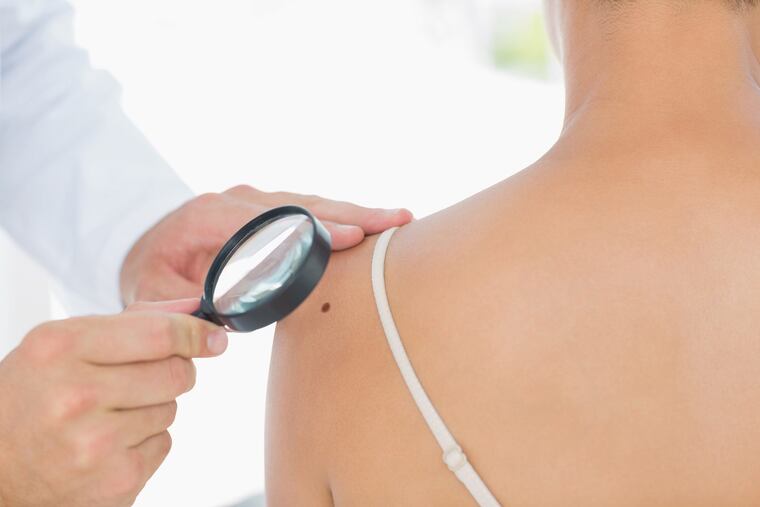What to know about skin checks, skin cancer monitoring | Expert Opinion
When in doubt, get new or abnormal moles checked out.

Many of the people who come into my dermatology office are pale, some with pink and peeling skin betraying their recent transgressions, most with brown spots, and changes from years of worshiping the sun.
My job is not to judge — I want to grant my patients reprieve, for surely they should not apologize for living a good life.
But how do you know if you need a skin check or skin cancer screening? Is being light-skinned enough of a reason? Skin cancers are the most common type of cancers in humans and anyone can get them — regardless of their skin color.
Unfortunately, we do not have universal guidance on who should get skin checks. Here are some questions to consider to help you decide how best to monitor for skin cancer.
How should I monitor my own skin?
It’s a good idea to take a look at your body and get a sense of what spots and changes you have on your body at baseline. If you notice a new or changing mole or lesion on your skin, you should see a dermatologist. That alone is reason enough to see us for an evaluation, and may merit a full skin check while you are in the office.
Most moles and spots on your skin may change slowly over time, but in general, if something seems off, see a doctor. It’s not your expertise to know what is and isn’t dangerous. Your job is to look for the clues, and we’ll do the worrying for you.
What is a skin check?
A skin check is a full body skin examination meant to screen for cancer in patients at higher risk. It’s making sure everything is OK, like a skin wellness check.
Each dermatologist will examine a patient differently — some have patients standing up, some lying on an exam table. Many of us also use a special tool to aid our visual exam called a dermatoscope, which is essentially a fancy magnifying glass supported by polarizing light to better appreciate skin structures.
When I examine the skin, personally I start with the patient sitting and study the hands, then the face. I examine the hair and scalp, and then the feet. Then I have patients stand up so I can examine their backs and back of their legs, and then turn to the front of the body, all while trying to respect patient privacy, keeping everything as covered as possible, examining one area at a time.
Who should get an annual skin check?
Opinions may vary, but a consensus of dermatologists would agree that all of the following people should be seen yearly:
People with a personal history of any skin cancer
People with a first-degree family member (parent or sibling) with a history of melanoma
People with more than 50 or subjectively large/atypical moles
People who have a strong history of tanning bed use or many severe sunburns
People with weakened immune systems (on immunosuppressant medications or with immunodeficient conditions).
Every patient is an individual, and we will base our recommendations on each person’s risks. And we are always happy to screen anybody to give them peace of mind, even if they do not have especially high risk, and make an assessment about their risk and need for future regular screening.
Darker-skinned patients, in part due to protective effects of melanin, have a lower risk (but not no risk) for skin cancer, so unless there is a family history or immune system issue, we usually will not recommend regular skin checks.
People of all skin tones should seek out a dermatologist when there is any question about something new or changing.
What is a biopsy?
If a lesion is concerning, we may recommend a skin biopsy. This minor procedure takes only a couple minutes and involves cleaning the affected area, numbing the area with an anesthetic injection, and then typically shaving off the concerning lesion with a small curved blade.
This specimen will then be processed onto a slide examined under a microscope by a pathologist. If the lesion shows signs of being cancerous or especially atypical, we may recommend an excision to cut the lesion completely out. For most skin cancers, this will complete the treatment.
Dermatologists want to help, not judge
When the exam is finished, patients often feel the need to explain themselves, confessing how they laid out in the sun, applied oils or used reflectors because they didn’t know how dangerous it was. Again, a good dermatologist should provide a judgment-free zone.
But for light-skinned folks looking to prevent skin cancers and everyone (dark and light skinned) looking to prevent skin aging and hyperpigmentation, we do recommend avoiding excess sun and regularly wearing sunscreen, SPF 30 or greater and reapplying it, in addition to photo-protective clothing.
Our practice and others regularly provide free skin cancer screenings. You can find lists of free screenings on the American Academy of Dermatology website: https://www.aad.org/public/public-health/skin-cancer-screenings/find-a-screening
Jules Lipoff practices as a board-certified dermatologist for Advanced Dermatology and Cosmetic Surgery in Manayunk/Roxborough and an adjunct clinical associate professor in the Department of Dermatology at Temple University’s Lewis Katz School of Medicine.